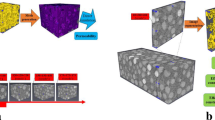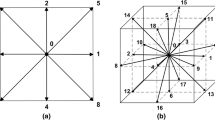Abstract
This work is part of an attempt to quantify the relationship between the permeability tensor (K) and the micro-structure of natural porous media. A brief account is first provided of popular theories used to relate the micro-structure toK. Reasons for the lack of predictive power and restricted generality of current models are discussed. An alternative is an empirically based implicit model whereinK is expressed as a consequence of a few “pore-types” arising from the dynamics of depositional processes. The analytical form of that implicit model arises from evidence of universal association between pore-type and throat size in sandstones and carbonates. An explicit model, relying on the local change of scale technique is then addressed. That explicit model allows, from knowledge of the three-dimensional micro-geometry to calculateK explicitly without having recourse to any constitutive assumptions. The predictive and general character of the explicit model is underlined. The relevance of the change of scale technique is recalled to be contingent on the availability of rock-like three-dimensional synthetic media. A random stationary ergodic process is developed, that allows us to generate three-dimensional synthetic media from a two-dimensional autocorrelation functionr(λ x ,λ y ) and associated probability density function∈ β measured on a single binary image. The focus of this work is to ensure the rock-like character of those synthetic media. This is done first through a direct approach:n two-dimensional synthetic media, derived from single set (∈ β ,r(λ x ,λ y )) yieldn permeability tensorsK i i-1,n (calculated by the local change of scale) of the same order. This is a necessary condition to ensure thatr(λ x ,λ y ) and∈ β carry all structural information relevant toK. The limits of this direct approach, in terms of required Central Process Unit time and Memory is underlined, raising the need for an alternative. This is done by comparing the pore-type content of a sandstone sample andn synthetic media derived fromr(λ x ,λ y ) and∈ β measured on that sandstone-sample. Achievement of a good match ensures that the synthetic media comprise the fundamental structural level of all natural sandstones, that is a domainal structure of well-packed clusters of grains bounded by loose-packed pores.
Similar content being viewed by others
Abbreviations
- C k :
-
adjustable parameter
- d j :
-
diameter of the throats associated to the pores of thejth type (m)
- |F e (v x ,v y )|2 :
-
squared Fourier modulus of the Fourier transform (subscripte indicates that the micro-geometry has been 0-appended).
- F(v x ,v y ):
-
Fourier modulus of the Fourier transform
- F :
-
formation factor
- k :
-
scalar component of Darcy's law permeability tensor (m2, 1 darcy ≊10−12 m2)
- K :
-
Darcy's law permeability tensor (m2, 1 darcy≊10−12 m2)
- l c :
-
threshold length from mercury injection (m)
- L c :
-
length-scale at which the micro-structure is no longer correlated
- l β :
-
mean pore size (m)
- l σ :
-
mean grain size (m)
- Np j :
-
number of pores of thejth type per μm2
- P c :
-
capillary pressure (N/m2)
- r0:
-
characteristic length-scale of the local geometrical Representative Elementary Volume (m)
- r0:
-
characteristic length-scale of the local Darcy's Representative Elementary Volume (m)
- r(λ x ,λ y ):
-
2-D autocorrelation function
- V β (r0):
-
local geometrical Representative Elementary Volume (m3)
- V β (r0):
-
local averaging volume of Darcy's type (m3)
- (λ x ,λ y ):
-
2-D spatial wave-length expressed in a local Cartesian basis (m)
- (V x ,V y ):
-
2-D spatial wave-number expressed in a local Cartesian basis
- ε(V x ,V y ):
-
complete phase of the Fourier transform
- ζ(V x ,V y ):
-
part of the phase of the Fourier transform
- ∈β :
-
volume fraction of the void phase (porosity)
References
Adler, P. M., Jacquin, C. G. and Quiblier, J. A.: 1990. ‘Flow in Simulated Porous Media’,Int. J. Multiphase Flow 16(4), 691–712.
Anguy, Y., Bernard, D. and Ehrlich, R.: 1994a, ‘The Local Volume Averating Technique for Modelling Flow in Natural Porous Media (1): Numerical Tools’,Advances in Water Resour. 17, 337–351.
Anguy, Y., Ehrlich, R., Prince, C. M., Riggert, V. and Bernard, D.: 1994b, ‘The Sample Support Problem for Permeability Assessment in Reservoir Sandstones’, in J. M. Yarus and R. L. Chambers (eds.),A.A.P.G. Computer Applications in Geology No. 3, pp. 37–54.
Anguy, Y.: 1993,Application de la Prise de Moyenne Volumique à l'Etude de la Relation entre le Tenseur de Perméabilité et la Microgéométrie des Milieux Poreux Naturels thèse Univ. Bordeaux 1, 170 pp.
Azam, M. I. S. and Dullien, F. A. J.: 1977, ‘Flow in Tubes with Periodic Step Changes in Diameter: A Numerical Solution’,Chem. Eng. Sci. 32, 1445–1555.
Bernard, D., 1995, ‘Using the Volume Averaging Technique to Perform the First Change of Scale for Natural Random Porous Media’, in G. Gambolati (ed.),Advanced Methods for Groundwater Pollution Control, Springer Verlag, New York, pp. 9–18.
Brames, B. J.: 1987. ‘Efficient Methods of Support Reduction’,Opt. Commun. 64, 333–337.
Bryant, S.L., King, P.R. and Mellor, D. W.: 1993, ‘Network Model Evaluation of Permeability and Spatial Correlation in a Real Random Sphere Packing’,T.i.P.M. 11, 53–70.
Chatzis, I. and Dullien, F. A. J.: 1977. ‘Modelling Pore Structure by 2-D and 3-D Networks with Application to Sandstones’,J. Canad. Pet. Techno. 16, 97–108.
Dullien, F. A. J.: 1979,Porous Media: Fluid Transport and Pore Structure, New York, Academic Press, 396 p.
Dullien, F. A. J.: 1975, ‘New Network Permeability Model of Porous Media’,A.I. Ch.E. J. 21((2), 299–307.
Ehrlich, R., Crabtree, s. J., Horkowitz, K. O. and Horkowitz, J. P.: 1991a, ‘Petrography and Reservoir Physics I: Objective Classification of Reservoir Porosity’,A.A.P.G. Bulletin 75(10), 1547–1562.
Ehrlich, R., Etris, E. L., Brumfield, D., Yan, L. P. and Crabtree, S. J.: 1991b, ‘Petrography and Researvoir Physics III: Physical Models for Permeability and Formation Factor’,A.A.P.G. Bulletin 75 (10), 1579–1592.
Garboczi, E.J.: 1990, ‘Permeability, Diffusivity and Micro-Structural Parameters: A Critical Review’,Cement and Concrete Research 20, 591–601.
Graton, L. C. and Fraser, H. J.: 1935, ‘Systematic Packing of Spheres with Particular Relation to Porosity and Permeability’,J. Geology 43(8), 785–909.
Gujar, U. G.: 1967,Generation of Random Signals with Specified Probability Density Functions and Power Density Spectra, M.Sc.E. thesis, Dept. of Elec. Engng., Univ. of New Brunswick, Frediriction, N.B., Canada.
Haring, R. E. and Greenkorn, R. A.: 1970, ‘Statistical Models of Porous Medium with Non-Uniform Pores’,A.i.Ch.E. J. 16(3), p. 477.
Hayes, M. H. and McClellan: 1982, ‘Reducible Polynomials in More than One Variable’,Proc. I.E.E.E. 70, 197–198.
Joshi, M. Y.: 1979,A Class of Stochastic Models for Porous Media, Ph.D. Dissertation, Engng. Petroleum, Univ. of Kansas, 154 pp.
McCreesh, C. A., Ehrlich, R. and Crabtree, S. J.: 1991, ‘Petrography and Reservoir Physics II: Relating Thin Section Porosity to Capillary Pressure, the Association between Pore Types and Throat Sizes’,A.A.P.G. Bulletin 75(10), 1563–1578.
Miesch, A. T.: 1976, ‘Q-Mode Factor analysis of Geochemical and Petrologic Data Matrices with Constant Row Sums’, U.S. Geoll. Surv. Prof. Pap., 574-G, 47 pp.
Prince, C. M., Ehrlich, R. and Anguy, Y.: 1995, ‘Analysis of Spatial Order in Sandstones II: Grain Clusters, Packing Flaws and the Small-Scale structure of Sandstones’,J. of Sed. Research A 65(1), 13–28.
Quiblier, J. A.: 1984. ‘A New Three-Dimensional Modeling Technique for Studying Porous Media’,J. of Colloid and Interface Sci. 98(1), 84–101.
Riggert, V. L.: 1994,Petrophysical Relationships of Pores and Pore Throats to Spatial Fabric Elements in Sandstones and their Implications for Fluid and Electrical Flow, Ph.D. thesis, Univ. of South Carolina, 192 pp.
Scheidegger, A. E.: 1974,The Physics of Flow Through Porous Media, University of Toronto Press, 353 pp.
Thompson, A. H.: 1991. ‘Fractals in Rock Physics’,Annu. Rev. Earth Planet Sci. 19, 237–262.
Ventzel, H.: 1973,Théorie des Probabilités, eds. Mir Moscou, 584 pp.
Whitaker, S.: 1986, ‘Flow in Porous Media 1: A Theoretical Derivation of Darcy's Law’,T.i.P.M. 1, 3–25.
Author information
Authors and Affiliations
Rights and permissions
About this article
Cite this article
Anguy, Y., Bernard, D. & Ehrlich, R. Towards realistic flow modelling. Creation and evaluation of two-dimensional simulated porous media: An image analysis approach. Surv Geophys 17, 265–287 (1996). https://doi.org/10.1007/BF01904044
Issue Date:
DOI: https://doi.org/10.1007/BF01904044




